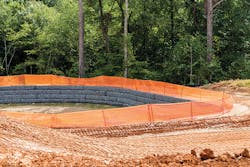The site work industry has progressed steadily over the past few decades, with more advanced technology and options available at our disposal. This is especially true in regard to erosion control. From my perspective, the most difficult part of it all has been compliance, specifically on construction sites. The question is why? And what can we do about it?
Before a solution can be found, the reason behind the problem must first be identified. Why is it that contractors readily comply with most other requirements of a construction project, but oftentimes try to find a way around best management practices of erosion and sediment control?
It all starts with the pre-construction estimate. Many sitework estimates are incomplete in the erosion control division. There are a few variables that impact this gross error. Before we review the components and solutions, let’s first understand why it is so important to have a proper estimate to enable better compliance.
The other day my teenage son declared that he needs a new pair of sneakers. More so, he needs them to be a certain brand that is pretty costly. I promptly gave him a lesson on the difference between needs and wants, and spent some time explaining why the lower cost brands will do just fine. However, if I walked into the store, and was told that I just won a free pair of sneakers of my choosing, can I honestly say that I would choose the same pair I had the intention of buying when I lectured my son? Absolutely not! There would be no reason to.
When there is enough money in the budget for erosion control, contractors have no reason to cut corners. But if they have to reach into their own pockets to comply, then they have to find every possible reason why all of it is nonsense, and sometimes they conclude that it doesn’t work anyhow.
It is imperative that an estimator understands the objectives of erosion and sediment control. Unlike other components of a construction project, the erosion control plan as delineated by the design engineer is only a guide—a presumption of what might work given a set of variables. An allowance must be made for alternative possibilities.
There are components of erosion control that are not delineated by a line or an area. For example, dust control will likely be described in a note either on the plans or within the Stormwater Pollution Prevention Plan (SWPPP). This is not a soft cost. This is not a “by the way.” There needs to be a serious allotment of funds in the estimate of costs for this item. The same is true with other items, such as road cleaning and sweeping, temporary soil stabilization, and so on. These are necessary to meet the objectives of erosion and sediment control.
Proper installation is another major contender in inefficient erosion control, within the estimates just as much as in the field. If the estimator allots a unit cost to install silt fence that only allows the contractor to stick it in the ground without proper trenching, then we are back at the shoe dilemma when it comes to installation. When costs haven’t been budgeted for, contractors will resist spending their own money.
Considering the expected duration of the job and the required maintenance of all best management practices until permanent stabilization is vital to achieving a viable estimate. Maintenance of BMPs is a large part of proper erosion control and requires real funds. For example, a construction entrance pad needs to be cleaned and most likely topped off with fresh stone. Removal and disposal of accumulated sediment from many other items is key to their functioning properly. If the estimator understands that and allows for that, the contractor should have enough money to implement these erosion control measures in the field.
As a good practice in all other areas of construction estimating, the unique components of the project need to be reviewed in light of how they may affect proper erosion and sediment control. Different seasons, soils types, the availability of resources, and the scope of work to be performed can all impact erosion and sediment control. For example, if the project has a lot of proposed poured concrete, should there be more washout stations or perhaps some more money for the maintenance of those already figured for? Remember that a construction project is dynamic. As the work progresses, the job site may require varied management practices.
Good shoes and viable estimates, they all merge in my life. I urge my fellow CPEs (Certified Professional Estimators) to give my fellow CPESCs (Certified Professionals in Erosion and Sediment Control) a solid pair of shoes. You are in control of the coupons. You may not be the lowest bidder on every job; however, you will be one of the most qualified. I will take that any day!
Rifka Malik
Rifka Malik is the president of Sitework Estimating Services Inc. and has spent over 20 years in the construction industry, specializing in sitework. She is a Certified Professional in Erosion and Sediment Control (CPESC) and a Certified Professional Estimator (CPE). She is an independent consulting estimator, a presenter of seminars, and has published constructionrelated articles in relevant publications.








